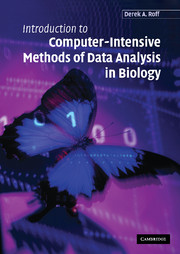Book contents
- Frontmatter
- Contents
- Preface
- 1 An Introduction to Computer-intensive Methods
- 2 Maximum Likelihood
- 3 The Jackknife
- 4 The Bootstrap
- 5 Randomization and Monte Carlo Methods
- 6 Regression Methods
- 7 Bayesian Methods
- References
- Appendix A An Overview of S-PLUS Methods Used in this Book
- Appendix B Brief Description of S-PLUS Subroutines Used in this Book
- Appendix C S-PLUS Codes Cited in Text
- Appendix D Solutions to Exercises
- Index
Appendix B - Brief Description of S-PLUS Subroutines Used in this Book
Published online by Cambridge University Press: 09 December 2009
- Frontmatter
- Contents
- Preface
- 1 An Introduction to Computer-intensive Methods
- 2 Maximum Likelihood
- 3 The Jackknife
- 4 The Bootstrap
- 5 Randomization and Monte Carlo Methods
- 6 Regression Methods
- 7 Bayesian Methods
- References
- Appendix A An Overview of S-PLUS Methods Used in this Book
- Appendix B Brief Description of S-PLUS Subroutines Used in this Book
- Appendix C S-PLUS Codes Cited in Text
- Appendix D Solutions to Exercises
- Index
Summary
General routines such as “log”, “print” etc. are omitted. Arguments set at the default values are not displayed. For a complete description, see the language reference section in S-PLUS.
anova(Model) Compute an ANOVA table for Model
anova(Model1, Model2, test=“F”) Compare Model1 and Model2
aov(formula, data =) Fit an analysis of variance model using formula on data
as.numeric(x) returns a vector like x, but with storage mode “double,” if x is a simple object of mode “numeric.” Otherwise, as.numeric returns a numeric object of the same length as x and with data resulting from coercing the elements of x to mode “numeric.”
bootstrap(data = statistic, B = trace = F) Performs bootstrap for observations in data = using the statistic specified by statistic. The number of replicates is B and trace determines printing of replicate number during computation.
by(X, Indices, function) Split dataset X by Indices and apply function to each part.
c Concatenates objects into a vector or a list (e.g., c(0.5, 0.2)).
cbind() Returns a matrix that is pieced together, column-wise, from several vectors and/or matrices.
ceiling() Creates integers from floating point numbers by going to the next larger integer.
chisq.test(x, correct = F) Chi-square contingency test using x. Apply Yates correction if correct = T
choose(n, k) Is the binomial coefficients, n!/(k!(n−k)!)
contourplot(Z ∼ X*Y, data=, at=0, xlab=“X”, ylab=“Y”) Contour plot of Z on X, Y. In above example, a single contour line of zero (at=0) is drawn.
convert.col.type(target = X, column.spec =, column.type =) Converts column(s), column.spec, in a 1- or 2-dimensional dataset, X, to a particular data type, column.type.
cor(X, Y, na.method = “omit”) Returns the correlation of a vector or the correlation matrix of a data matrix. Missing values can be omitted or the calculation set to “fail.”
[…]
Information
- Type
- Chapter
- Information
- Publisher: Cambridge University PressPrint publication year: 2006
